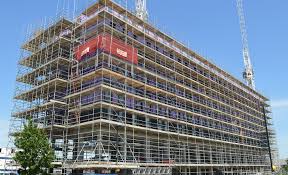- WORLD BANK KICK-OFF INSPECTION OF USMID PROGRAM IN UGANDA
- ALGERIA MINISTER RECIEVED HARBOR ENERGY CEO OVER ENERGY PARTNERSHIP
- CAN INNOVATION OUTRUN DROUGTH IN MOROCCO ONGOING WATER MANAGEMENT CRISIS
- SCZONE SIGNED DEAL WITH CHINESE INVESTORS FOR IRON PRODUCTS PROJECTS IN EGYPT
- WESTPROP HOLDING LIMITED SET TO EMBARKED ON PIPELINE PROJECT IN ZIMBABWE
The Do’s & Don’ts of Scaffold Safety in Construction

We all know that fall hazards are the leading cause of construction workers deaths, and this accounts for about 40% of all fatalities in construction each year. Of the 222 construction worker fatalities attributed to falls in 2017, about 9% were from scaffolds. OSHA estimates that about 65% of all construction workers perform some work on scaffolds every year. That’s a lot of people working on scaffolds potentially being exposed to a number of hazards such as falls, electrocutions and falling objects.
The key issue to safety when working on scaffolding boils down to whether or not the scaffold is safe to work on. This means working on scaffolding that has been erected by trained professionals under the supervision of a competent person and that the scaffold has been properly inspected before use. It is also important that each worker is equipped with proper protective equipment and have been thoroughly trained on safe work practices when working on scaffolding.
Do’s
- Get properly trained before using a scaffold. Training must be done by a qualified person and includes identification of electrocution, fall and falling objects hazards and the procedures for dealing with those hazards. Training must also include the proper use of the scaffold, how to handle materials and the load capacities of the scaffold.
- Get retrained when additional hazards present themselves due to changes at the job-site or if the type of scaffold, fall protection or falling objects protection changes. You can also be required to receive additional training if your boss feels that your initial training was not adequately retained.
- Before getting on a scaffold check to make sure that a competent person has inspected the scaffold before the work shift and that it is safe to use and in proper working order. Scaffolds can only be erected, dismantled, altered or moved under the direct supervision of a competent person or trained personnel. If you are ever unsure regarding the safety of a scaffold check with a supervisor before use.
- Always wear your hard hat when working on, under or around a scaffold. You should also get a good sturdy, non-skid pair of work boots and consider using tool lanyards when working on scaffolds.
- Be mindful of coworkers working above and below you at all times, as well as others working on the scaffold. If you witness improper use on or around a scaffold you should stop what you are doing and notify a supervisor.
- When personal fall arrest systems are required for the scaffold you will be working on, thoroughly inspect the equipment for damage and wear. Anchor the system to a safe point that won’t allow you to free fall more than six feet before stopping.
Don’ts
- Do not leave anything on the scaffold at the end of your shift. This includes any building materials or tools that you may have been using on the scaffold while you were working. These items could potentially be blown off the scaffold or cause tripping hazards for the next person using the scaffold.
- Do not overload the scaffold. Proper training includes being informed of the maximum intended load of the scaffold you are working on as well as its load-carrying capacities. In most instances, scaffolds should be capable of supporting at least four times its maximum intended load.
- Do not use boxes or ladders to increase your work height. If you can’t reach an area you should request that your supervisor has the scaffold platform raised. Don’t use stilts unless the guardrails on the scaffold have been extended to a height that is equal to the height of the stilts.
- Do not use the scaffold if it appears that it is damaged in any way, has been tampered with or if there are components missing such as planking, guardrails, toe-boards, debris nets or protective canopies. Notify a supervisor immediately to get the scaffold in proper working order and inspected by a competent person. Never tamper with or attempt to repair a scaffold unless you have received training in scaffold erection.
- Do not walk on scaffold planking covered in ice, snow or mud. Worn wood planking can also be extremely slippery when wet. All snow, ice, mud and other debris such as wet leaves should be thoroughly removed before using the scaffold. You should also avoid using a scaffold during adverse weather such as heavy rain, sleet, ice snow or strong winds.
- Do not climb on any portion of the scaffold frame not intended for climbing. Always use a fixed ladder, internal access stairway or built-in ladder to access the working platform. There should always be a handhold above the scaffold platform. Never climb with any materials or tools in your hand, they should be hoisted up to the scaffold separately.
OSHA defines a competent person as “one who is capable of identifying existing and predictable hazards in the surroundings or working conditions which are unsanitary, hazardous, or dangerous to employees, and who has the authorization to take prompt corrective measures to eliminate them.” A qualified person is “one who, by possession of a recognized degree, certificate, or professional standing, or who by extensive knowledge, training, and experience, has successfully demonstrated his/her ability to solve or resolve problems related to the subject matter, the work, or the project.”
In Summary, be careful when using any scaffold because the purpose of a working scaffold is to provide a safe working platform and access suitable for work crews to carry out their work.

